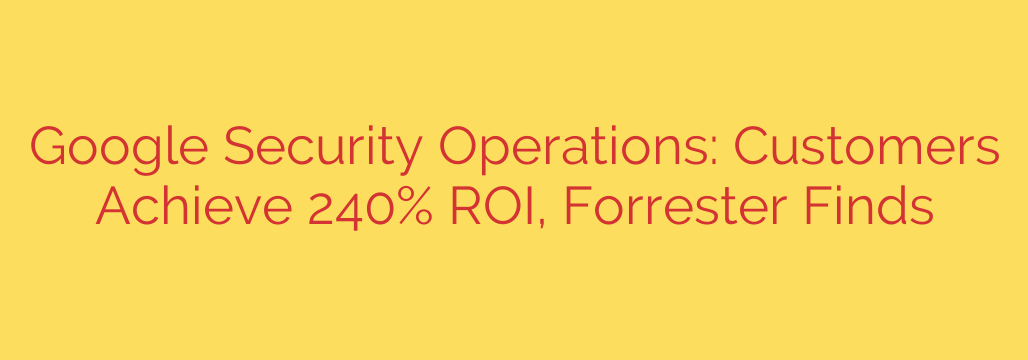
The Surprising ROI of Modern Security Operations: More Than Just Defense
In today’s complex threat landscape, cybersecurity is often viewed as a necessary but costly expense—a defensive measure that drains budgets without contributing to the bottom line. But what if the right security platform could do more than just defend your organization? What if it could deliver a significant and quantifiable return on investment (ROI)?
Recent independent analysis of organizations that have upgraded to a modern, unified security operations platform reveals staggering financial benefits. By moving away from siloed, legacy systems to an integrated solution, businesses are not just improving their security posture; they are unlocking tremendous value.
The findings are compelling. A composite organization, representing multiple companies across various industries, experienced:
- A remarkable 240% return on investment (ROI) over three years.
- A full payback on their investment in less than six months.
- Over $7.7 million in total financial benefits realized during the three-year period.
These aren’t just abstract numbers. They represent a fundamental shift in how we should view security spending. A modern SecOps platform is no longer just a cost center—it’s a powerful business enabler.
How Do These Platforms Generate Such High Returns?
The impressive ROI is driven by concrete improvements across three critical areas: risk reduction, operational efficiency, and cost consolidation.
1. Drastically Reducing the Risk of a Material Breach
The most significant financial benefit comes from avoiding the catastrophic costs of a major security incident. Modern platforms achieve this by integrating threat intelligence, advanced analytics, and automated response capabilities.
The analysis found that organizations were able to achieve a 65% reduction in the likelihood of a material security breach. By detecting threats faster and responding more effectively, companies can prevent incidents from escalating into full-blown crises that involve regulatory fines, reputational damage, and massive recovery costs. This proactive risk mitigation is the single largest contributor to the platform’s ROI.
2. Boosting SOC Analyst Efficiency and Effectiveness
Security Operations Center (SOC) teams are often overwhelmed, understaffed, and burned out from chasing false positives and switching between dozens of disparate tools. A unified platform tackles this problem head-on.
By combining security information and event management (SIEM) with security orchestration, automation, and response (SOAR) in a single interface, these platforms supercharge analyst productivity. The result is a 75% improvement in SOC analyst efficiency. Analysts can investigate and respond to threats in minutes, not hours, because all the necessary data, context, and response tools are in one place. This frees up valuable time for proactive threat hunting and strategic initiatives.
3. Slashing Legacy Costs and Engineering Overhead
Many organizations are trapped in expensive, inflexible contracts for legacy SIEM solutions that are difficult to manage and scale. Migrating to a modern, cloud-native platform can lead to immediate and substantial savings.
The study highlighted a 40% reduction in costs associated with previous SIEM solutions. Furthermore, businesses saved an estimated $1.4 million in engineering and content development costs. Because a modern platform is delivered as a service and comes with pre-built detection rules and automated playbooks, organizations no longer need large teams dedicated to maintaining and customizing their security tools.
Actionable Security Tips: Evaluating Your Own Security ROI
These findings provide a clear blueprint for any organization looking to enhance its security posture while justifying the investment. Here are a few steps you can take:
- Audit Your Current Security Stack: Identify all your separate security tools (SIEM, SOAR, threat intelligence feeds, etc.). Calculate their total cost of ownership, including licensing, maintenance, and the personnel required to manage them.
- Quantify Your Analyst Workload: Track the average time it takes for your team to detect, investigate, and respond to a critical alert. This will reveal bottlenecks and inefficiencies that a unified platform could solve.
- Evaluate Unified Platforms: When assessing new solutions, prioritize those that offer integrated SIEM, SOAR, and high-fidelity threat intelligence out of the box. Look for platforms built on a scalable architecture that can handle massive data volumes without performance degradation.
- Prioritize Automation: The key to efficiency and speed is automation. Ensure any new platform can automate routine tasks like data enrichment, alert triage, and initial response actions.
Security as a Value Driver, Not a Cost Center
The evidence is clear: investing in a modern security operations platform is one of the smartest financial decisions a business can make today. It moves cybersecurity from a defensive necessity to a strategic advantage that reduces risk, boosts productivity, and delivers an incredible return on investment. By fundamentally changing how you detect, investigate, and respond to threats, you can protect your organization more effectively while strengthening your financial future.
Source: https://cloud.google.com/blog/products/identity-security/forrester-study-customers-cite-240-percent-roi-with-google-security-operations/








